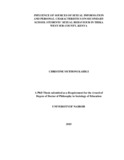| dc.description.abstract | The purpose of this research was to investigate reliable sources of sexual
information for secondary school students that influence their sexual
behaviour. This research was carried out in Kenya, specifically Thika West
sub-County. It was conducted among sampled secondary school students, their
head teachers and teacher counsellors. The specific objectives of the study
were to: establish how sexual information obtained through the school
curriculum influences secondary school students’ sexual behaviour; establish
how sexual information received through the family setting influences
secondary school students’ sexual behaviour; investigate how sexual
information received through religious institutions influences secondary
school students’ sexual behaviour; establish how sexual information obtained
through the peer group influences secondary school students’ sexual
behaviour; investigate how sexual information accessed through the media
influences secondary school students’ sexual behaviour; and how students’
personal characteristics influence their sexual behaviour. The study was
carried out using survey research design and was guided by six hypotheses.
Research tools used comprised questionnaires for student respondents and
interview schedules for head teachers and teacher counsellors. The data
collected was processed using Statistical Package for Social Sciences (SPSS
IBM statistics 21). The statistics were tabulated and subjected to regression
analysis using ANOVA and coefficient models. Pertinent findings have
indicated that: an overwhelming proportion of secondary school students are
sexually active. This may have contributed in a rise in cases of premarital
pregnancies and subsequent abortions, student drop out from schools, Human
Immune Virus/Acquired Immune Deficiency Syndrome and Sexually
Transmitted infections. The results established that mass media as a source of
sexual information is the most influential, followed by peer group and school
curriculum respectively. However all respondents reported that the
information received through the school curriculum is too little and
economical especially on emotional aspects of sexuality. Sexual information
from the family members though considered as reliable is too little to be of
any significance on students’ sexual behaviour. Information received through
religious institutions is almost non-existent and has the lowest level of
significance on students’ sexual behaviour. Finally, students’ personal
characteristics of age and gender were revealed as influencing students’ choice
of being sexually active. Study results reveal that the preferred agents of
transmitting sexuality information were; school curriculum, media, family,
peer counsellors, and teacher counsellors respectively. Others mentioned
included religion, mentors, and specialized personnel. In a nutshell, there is no
any reliable source of sexual information that students can rely on. All student
respondents indicated their support for comprehensive sexuality information to
enable them avoid pitfalls from lack of knowledge. All key informants who
included head teachers and teacher counsellors supported that information
about the use of contraceptives should be made available to students. | en_US |

